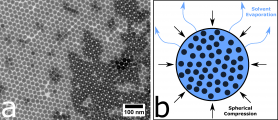
Chris Kennedy
Leonard S. Ornstein Laboratory, room 0.56
Princetonplein 1, 3584 CC Utrecht
P.O. Box 80 000, 3508 TA Utrecht
The Netherlands
phone: +31 (0)30 253 2315
secretariat: +31 (0)30 253 2952
e-mail: c.l.kennedy@uu.nl
Research
Promotor: Prof. dr. Alfons van Blaaderen
Funding: MCEC
Employed: 1 September 2015 – 31 August 2019
Link to the MCEC-research center
The primary aim of this project is to explore the possibility of enhancing the photocatalytic ability of high index nanoparticles by incorporating them into supraparticles (SP, self-assembled micro structures composed of many smaller particles). The focus will be on the splitting of water as a part of the Solar Fuels arm of the MCEC consortium. The steps towards this goal include the creation of suitable nanoparticles to act as SP building blocks and optimization of a method of SP assembly. To the latter end, a microfluidic approach will be investigated and compared to existing methods.
Colloidal Synthesis, Electron Tomography, Stimulated Emission Depletion (STED) Microscopy
The primary aim of this project is to explore the possibility of enhancing the photocatalytic ability of high index nanoparticles by incorporating them into supraparticles (SP, self-assembled micro structures composed of many smaller particles). The focus will be on the splitting of water as a part of the Solar Fuels arm of the MCEC consortium. The steps towards this goal include the creation of suitable nanoparticle building blocks and optimization of a method of SP assembly.
SPs are formed when their building blocks are compressed in spherical confinement [1,2,3]. This can be achieved experimentally by emulsifying a dispersion of nanoparticles in an immiscible solvent, and allowing the emulsion droplets (which contain the nanoparticles) to shrink by evaporation (Figure 1b). The emulsification methods which will be used in this project are mechanical shearing in a Taylor-Couette cell and one-by-one droplet formation in a microfluidic device. These are known to yield more monodisperse emulsions than other methods and this property determines the size uniformity of the resulting SPs.
In the first stage of the project, SP assembly will be investigated using silica nanospheres synthesised using a new amino acid catalysed method [4]. This synthesis yields silica seed particles of around 16 nm which can then be conveniently grown to a desired size (Figure 1a). Mixing particles of different size will allow the assembly of binary systems to be probed. SP structures will be examined using electron tomography (3D-TEM) and 3D-STED confocal microscopy (in the case of building block particles with diameter on the order of a few hundred nm). Later, catalytic SPs will be assembled from semiconductor and metal particle building blocks. Their structural, optical and photocatalytic properties will then be characterised.
Figure 1: a) TEM image of preliminary 24 nm silica nanospheres. b) Schematic illustration of supraparticle assembly system
[1] V. Manoharan et al., Science 301, 483-7 (2003)
[2] B. de Nijs et al., Nature Materials 14, 56-60 (2014)
[3] D. Vanmaekelbergh et al., ACS Nano 9, 3942-50
[4] S. Shahabi et al., J. Nanopart. Res. 17, 270 (2015)

